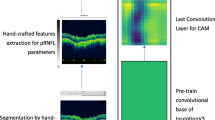Abstract
Peri-Papillary Atrophy (PPA) is a clinical finding related to chorioretinal diminishing and disorder analysis of the Retinal Pigment Epithelium (RPE) in the region encircling the optic disk. Optical Coherence Tomography (OCT) is an integral asset in clinical perform, used to survey retinal harm in a scope of illnesses. It gives ultra-high-resolution cross-sectional pictures of organic tissues utilizing nonobtrusive imaging innovation. Be that as it may, the examination by OCT is still less open in view of the astonishing costs in various ophthalmology centers wherever all through the world. The primary prerequisite for Peri-papillary-decay investigation in glaucoma analysis is early recognition of RNFL deterioration so as to arrange the treatment process as quickly as time permits. Henceforth, a mass screening agenda is by all accounts appropriate for supporting the finding. Fundus imaging is inexpensive and easily accessible rather than OCT imaging. The contemporary medical accomplishment needs to focus on the analysis procedure basis on the fundus image for the fulfillment of the huge demand of screening process for Glaucoma. In our work we are focusing on Peri-Papillary Atrophy Analysis (PPAA) using Retina Nerve Fiber Layer (RNFL) analysis using Fundus image of retina. In RNFL analysis, we need to identify RNFL loss. This RNFL misfortune can be moderately all around demonstrated as a surface change in fundus photos by analyzing the heterogeneous idea of the Peri-Papillary Atrophy area. RBF kernel based SVM classifier using LDA in combination is applied to achieve the motive of this literature. The experimental results reveal the benefits of the classifier worked on fourteen statistical features.
Access this chapter
Tax calculation will be finalised at checkout
Purchases are for personal use only
Similar content being viewed by others

References
Swathy Ravi V. A survey on glaucoma detection methods
Gopinath K, Sivaswamy J, Mansoori T. Automatic glaucoma assessment from angio-OCT images
Odstrcilik J, Kolar R, Tornow RP, Budai A, Jan J, Mackova P, Vodakova M. Analysis of the retinal nerve fiber layer texture related to the thickness measured by optical coherence tomography
Zayed N, Elnemr HA. Statistical analysis of Haralick texture features to discriminate lung abnormalities. Computer & Systems Department, Electronics Research Institute, Cairo
Odstrcilik J, Kolar R, Harabis V, Gazarek J, Jan J (2010) Retinal nerve fiber layer analysis via Markov random fields texture modelling. In: Proceedings of the 18th European signal processing conference, pp 1650–1654
Muramatsu C, Hayashi Y, Sawada A et al (2010) Detection of retinal nerve fiber layer defects on retinal fundus images for early diagnosis of glaucoma. J Biomed Opt 15, Article ID 016021
Tuulonen A, Alanko H, Hyytinen P, Veijola J, Seppänen T, Airaksinen PJ (2000) Digital imaging and micro texture analysis of the nerve fiber layer. J Glaucoma 9(1):5–9
Kolář R, Jan J (2008) Detection of glaucomatous eye via color fundus images using fractal dimensions. Radio Eng 17(3):109–114
Jan J, Odstrcilik J, Gazarek J, Kolar R (2012) Retinal image analysis aimed at blood vessel tree segmentation and early detection of neural-layer deterioration. Comput Med Imaging Graph 36(6):431–441
Bock R, Meier J, Michelson G, Nyul LG, Hornegger J (2007) Classifying glaucoma with image-based features from fundus photographs. Lect Notes Comput Sci (Springer) 4713:355–365
Mitra A, Roy S, Roy S, Setua SK (2018) Enhancement and restoration of non-uniform illuminated fundus image of retina obtained through thin layer of cataract. CMPB (Elsevier) 156(March):169–178. https://doi.org/10.1016/j.cmpb.2018.01
Mitra A, Banerjee PS, Roy S, Roy S, Setua SK (2018) The region of interest localization for glaucoma analysis from retinal fundus image using deep learning. Comput Method Program Biomed (Elsevier) 165(October):25–35. https://doi.org/10.1016/j.cmpb
Yogesan K et al (1998) Tele‐ophthalmic screening using digital imaging devices. Aust N Z J Ophthalmol 26:S9–S11
Haralick RM, Shanmugam K, Dinstein I (1973) Textural features for image classification. In: IEEE transactions on systems, man, and cybernetics, vol SMC-3, no 6, pp 610–621. https://doi.org/10.1109/TSMC.1973.4309314
Srinivasan G, Shobha G (2008) Statistical Texture Analysis
Galloway MM (1975) Texture analysis using gray level run lengths. Comput Graph Image Process 4:172–179
Dasarathy BR, Holder EB (1991) Image characterizations based on joint gray-level run-length distributions. Pattern Recognit Lett 12:497–502
Zongging L et al (2009) A variational approach to automatic segmentation of RNFL on OCT data sets of the retina. In: 16th IEEE international conference on image processing (ICIP), Cairo, Egypt, Nov 2009, pp 3345–3348
Roy S, Bhattacharyya D, Bandyopadhyay SK, Kim T-H (2018) Heterogeneity of human brain tumor with lesion identification, localization and analysis from MRI. Inform Med Unlocked (Elsevier) 13:139–150
Acknowledgements
The research presented in this paper was partially supported by Academy of Technology, University of Calcutta, Suryoday Eye Centre in technical collaboration with L. V. Prasad Eye Institute, Hyderabad, The Calcutta Medical Research Institute and The Currae Eye Hospital. The author would like to sincerely thank Dr. Debasis Chakrabarti, M.S., Fellow Glaucoma (LVPEI) of the Currae Eye Hospital and Dr. Sailaja Sengupta, M.S., Fellow Glaucoma (LVPEI) for their guidance and giving a free hand in choosing research directions.
Author information
Authors and Affiliations
Corresponding author
Editor information
Editors and Affiliations
Rights and permissions
Copyright information
© 2020 Springer Nature Singapore Pte Ltd.
About this chapter
Cite this chapter
Mitra, A. et al. (2020). Glaucoma Detection from Retinal Fundus Images Using RNFL Texture Analysis. In: Verma, O., Roy, S., Pandey, S., Mittal, M. (eds) Advancement of Machine Intelligence in Interactive Medical Image Analysis. Algorithms for Intelligent Systems. Springer, Singapore. https://doi.org/10.1007/978-981-15-1100-4_13
Download citation
DOI: https://doi.org/10.1007/978-981-15-1100-4_13
Published:
Publisher Name: Springer, Singapore
Print ISBN: 978-981-15-1099-1
Online ISBN: 978-981-15-1100-4
eBook Packages: Intelligent Technologies and RoboticsIntelligent Technologies and Robotics (R0)



